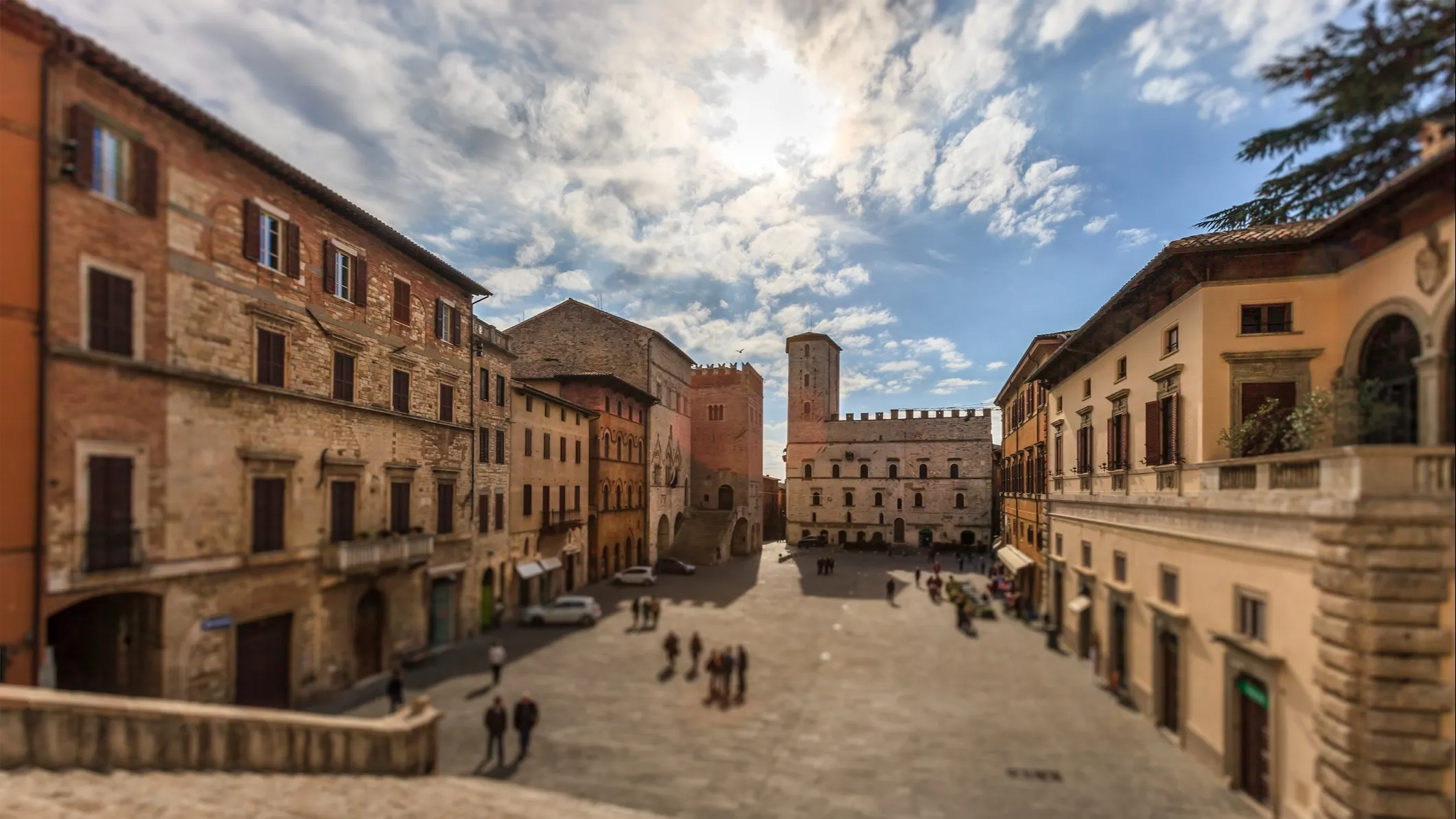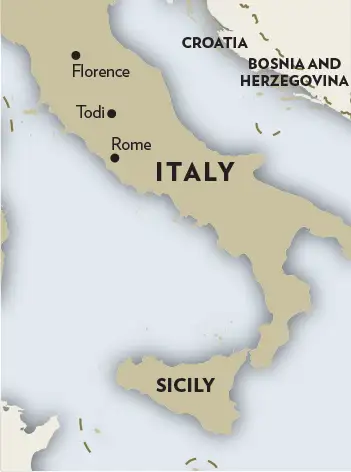I've rented a two-bedroom apartment in central Italy for May, Patricia wrote. It’s in Todi, a medieval walled village. It’s in Todi, a medieval walled village. I’m offering the extra bedroom to good friends like you.
Medieval walled village? Todi? I wasn’t even sure how to pronounce it. (It’s tow-dee, for the record.)
I was in the middle of launching my first novel, overwhelmed with a to-do list that felt longer than the book itself. Patricia, a friend and former colleague, had just offered me the chance to slow down after the book launch.
And returning to Italy was a chance at a welcome do-over. In my early 20s, I’d enjoyed many free trips to Italy courtesy of the US Navy. But I didn’t properly appreciate Italy’s true treasures of history, culture, and cuisine back then. As the years passed, I’d longed to return to the country with older, wiser eyes.
I’m in, I answered.
Through the Keystone Archway
In mid-May, I flew to Leonardo da Vinci-Fiumicino Airport, hopping trains to the Terni Station where Patricia picked me up. Passing through the lush Italian countryside in our tiny rental car, we fell back into familiar conversations—as if we’d last seen each other just two weeks—not two years—ago.
Meals are rarely rushed. Conversation flows.
Perched high under an intense Umbrian sun, Todi’s formidable limestone buildings cascade from a two-crested hilltop down to protective walls. Vespas and cars parked just outside the one-time defensive stronghold are the only interruptions of the strong fairytale feel. Stepping through a keystone archway in a side entrance to the village, my roller bag clacked on cobblestone. The sound harked back to the village’s early origins—a time when people traveled by foot or on horseback, when communities relied on each other.
According to myth, the city was built by Hercules. In actuality, it was likely built in the 8th or 9th century BC—contemperaneous with Rome, less than a two-hour drive away. Yet the walled town has managed to stay preserved in time.
Get Your Free Italy Report Today!
Get Your Free Italy Report Today!
Learn more about Italy and other countries in our daily postcard e-letter. Simply enter your email address below and we’ll send you a FREE report – Italy: Europe’s Most Seductive Country.

By submitting your email address, you will receive a free subscription to IL Postcards and special offers from International Living and our affiliates. You can unsubscribe at any time, and we encourage you to read more about our Privacy Policy.
A City True to Its Origins
The Italian press once touted Todi as the world’s most livable city, thanks to its small size and ability to stay true to its ancient origins. After spending a week there, it’s apparent why. As Patricia and I explored its labyrinthine streets, the vibrancy of its community was palpable. Sustainability and slow living are the preferences of the day. Meals are rarely rushed and conversation flows. Residents take pride in local sourcing.
Navigate the endless alleyways in Todi, and you may see a delivery man hauling a side of beef on his back, making his way to one of the many hidden restaurants within those alleys that boast expansive views of the Umbrian countryside from their patios.
Most restaurants cook their dishes from scratch with locally sourced ingredients. The restaurateur at La Cantina Del Mercataccio lovingly bragged his mom had made the pasta the day before. I enjoyed mine loaded with the black truffles grown in the region, where they are plentiful and celebrated. Nearby vineyards produce much of the wine paired with meals, including a Grechetto white, one of my new favorites made with the Grechetto di Todi grape.

Todi also engages its dynamic international community by hosting festivals and exhibitions, when its Piazza del Popolo becomes center stage. During my stay, the Todi Fiorita exhibition hit full bloom and colorful flowers filled the square, delighting onlookers. Later in July, those colors take flight as hot air balloons fill the sky over Todi for the Italian International Balloon Grand Prix.
Wander southwest from the square, and you’ll find the ascending staircases to Chiesa di San Fortunato, a Roman Catholic church at the top of Todi that dates back to the 12th century. It holds the relics of St. Fortunatus, the patron saint of Todi.
Life in the Slow Lane
On my first full day in Todi, Patricia and I met Grace, an American who had recently sold her beloved house in the California redwoods after COVID-19 forced her yoga studio to close.
Over a three-hour meal, we learned Grace’s father had been born in Italy, and many cousins still lived here. Grace had sought an Italian locale to be closer to family, and stretch her dollar the way California would never allow.
We also met Jennifer and Chad, Americans who’d relocated from Washington, DC to Amsterdam six years ago, but didn’t find the close-knit community they craved. Now, they live within Todi’s walls, enjoying panoramic vistas from their tiered garden, filled with olive trees, rosemary, lavender, and a small vegetable garden Jennifer grew this winter. They purchased their 3,200-sq-foot stone apartment for €430,00 ($464,000)… a third of their Amsterdam home’s cost.
Italy drew them initially with its tempting tax programs for expats, but once they moved to Todi, they found an unexpected gem in the thriving international community. Todi delivered a better social life than anywhere they’ve lived. They regularly interact with friends from across the globe: Americans, Australians, Swedes, Russians, and, of course, Italians. They still find opportunities to make new friends.
"I showed up at a book club recently knowing two of the people," Jennifer said, "but there were thirty I didn’t know."
The slow life has its downsides. Grace, Jennifer, and Chad agree: Expect any bureaucratic process and paperwork here to move slower than you may be used to

A Blast From the Past
Spending time with Grace and others, learning their stories, and reconnecting with my friend Patricia over long meals fed my craving for the sense of community that’s becoming rarer in the US.
While I’d come to Todi to experience Italy with a more mature perspective, I was struck by a sense of familiarity when dining outside, immersed in panoramic views.
As I sat down to one of my final meals in Todi on the patio of Ristorante Pizzeria Cavour overlooking the Umbrian landscape, I realized the source of my dèjá vu.
The rolling green foothills before me transported me to my childhood, where I’d spent large portions of the summer with extended family in similar hills in North Carolina. Grandparents, aunts, and uncles had built their homes on nearby peaks, the same ones my cousins and I lost ourselves in most summer days.
Back then, we relied on each other, our extended family, and the local community. I looked around the patio at other diners, all immersed in conversations, each with peaceful, unhurried expressions that are rare in the many places I visit.
Todi delivers a better social life than anywhere else.
I knew then why so many love calling the walled village of Todi their home. And why many more, including myself, would like to.
Get Your Free Italy Report Today!
Get Your Free Italy Report Today!
Learn more about Italy and other countries in our daily postcard e-letter. Simply enter your email address below and we’ll send you a FREE report – Italy: Europe’s Most Seductive Country.

By submitting your email address, you will receive a free subscription to IL Postcards and special offers from International Living and our affiliates. You can unsubscribe at any time, and we encourage you to read more about our Privacy Policy.
